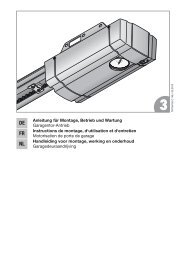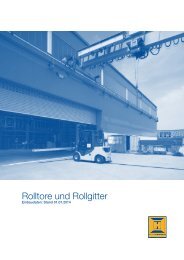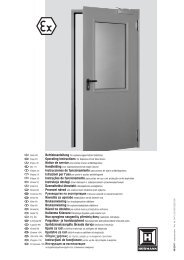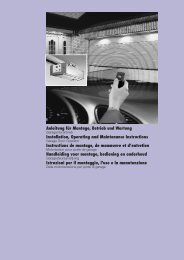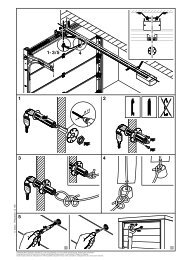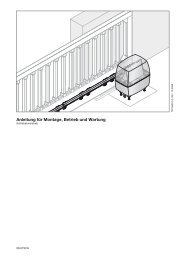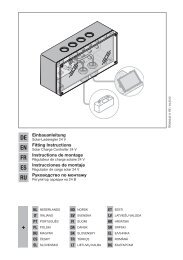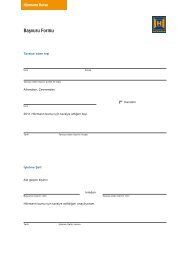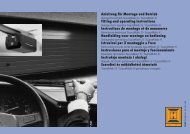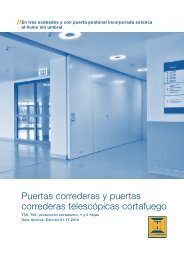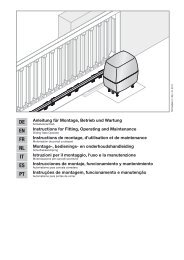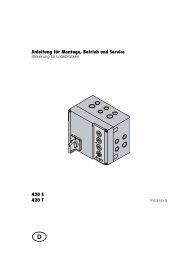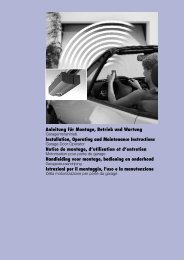Template BA B168xH238 - Hormann.fr
Template BA B168xH238 - Hormann.fr
Template BA B168xH238 - Hormann.fr
Create successful ePaper yourself
Turn your PDF publications into a flip-book with our unique Google optimized e-Paper software.
ENGLISH<br />
5.4 Programming the hand transmitter buttons on<br />
an integrated radio receiver<br />
1. Briefly press the small P button (see Figure 1) once<br />
(for channel 1 = impulse command), twice<br />
(for channel 2 = light command) or three times<br />
(for channel 3 =partial opening command).<br />
Pressing the small P button again will immediately end<br />
radio programming.<br />
Depending on the channel being programmed, the rim of<br />
the large T button will flash 1x (for channel 1) or 2x<br />
(for channel 2) or 3x (for channel 3). During this time,<br />
a hand transmitter button can be programmed for the<br />
desired function.<br />
2. Press the hand transmitter button to be programmed<br />
until the rim of the large T button flashes rapidly.<br />
The radio code of this hand transmitter button is now<br />
stored in the integrated radio receiver.<br />
5.5 Deleting all data in an integrated radio receiver<br />
▶ Press and hold the small P button.<br />
The rim of the large T button flashes slowly, signalling the<br />
readiness for deletion. The flashing then becomes more<br />
rapid. Afterwards, the programmed radio codes of all<br />
hand transmitters are deleted.<br />
5.5.1 Connecting an external radio receiver *<br />
Instead of the integrated radio receiver, an external<br />
1/2/3-channel radio receiver can be used for the impulse<br />
function (channel 1), light function (channel 2) and partial<br />
opening (channel 3) to control the roller garage door operator.<br />
Insert the plug of the receiver in the corresponding socket<br />
(see Figure 4). To avoid double assignments, delete the data<br />
of the integrated radio receiver when using an external radio<br />
receiver (see Deleting all data in an integrated radio receiver,<br />
page 29).<br />
5.6 Excerpt <strong>fr</strong>om the declaration of conformity<br />
for the receiver<br />
Conformity of the abovementioned product with the<br />
requirements of the directives according to article 3 of the<br />
R & TTE directives 1999/5/EC was verified by compliance<br />
with the following standards:<br />
• EN 60950:2000<br />
• EN 300 220-1<br />
• EN 300 220-3<br />
• EN 301 489-1<br />
• EN 300 489-3<br />
The original declaration of conformity can be requested <strong>fr</strong>om<br />
the manufacturer.<br />
6 Operation<br />
WARNING<br />
Danger of injury during door travel<br />
If people or objects are in the area<br />
around the door while the door is in<br />
motion, this can lead to injuries or<br />
damage.<br />
▶ Children are not allowed to play<br />
near the door system.<br />
▶ Make sure that no persons or<br />
objects are in the door's area of<br />
travel.<br />
▶ If the door has only one safety<br />
device, only operate the roller<br />
garage door operator if you are<br />
within sight of the door's area of<br />
travel.<br />
▶ Monitor the door travel until the<br />
door has reached the end-of-travel<br />
position.<br />
▶ Only drive or pass through remote<br />
control door systems if the door is<br />
in the Open end-of-travel position!<br />
▶ Never stay standing under the open<br />
door.<br />
Caution<br />
Danger of crushing in the side guide<br />
Do not reach into the side guide with your fingers during<br />
door travel, as this can cause crushing.<br />
▶ Do not reach into the guide rail during door travel.<br />
ATTENTION<br />
Overloading the release knob<br />
The release knob can be damaged by overloading.<br />
▶ Do not hang on the release knob with your body<br />
weight.<br />
6.1 Instructing users<br />
▶ All persons using the roller garage door operator must<br />
be shown how to operate it properly and safely.<br />
▶ Demonstrate and test the mechanical release as well as<br />
the safety reversal.<br />
6.2<br />
Function check<br />
▶<br />
To check the safety reversal,<br />
stop the door with both hands<br />
while it is closing.<br />
The door system must stop and<br />
initiate the safety reversal. The<br />
door system must also switch off<br />
and stop the door while it is<br />
opening.<br />
* Accessory, not included as standard equipment!<br />
TR10A073-B RE / 02.2012 29




